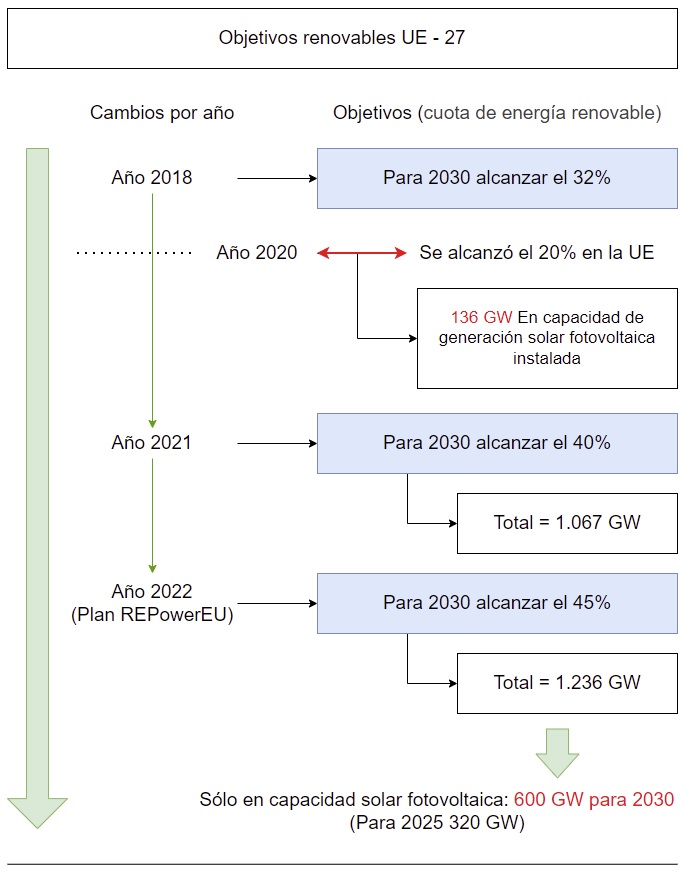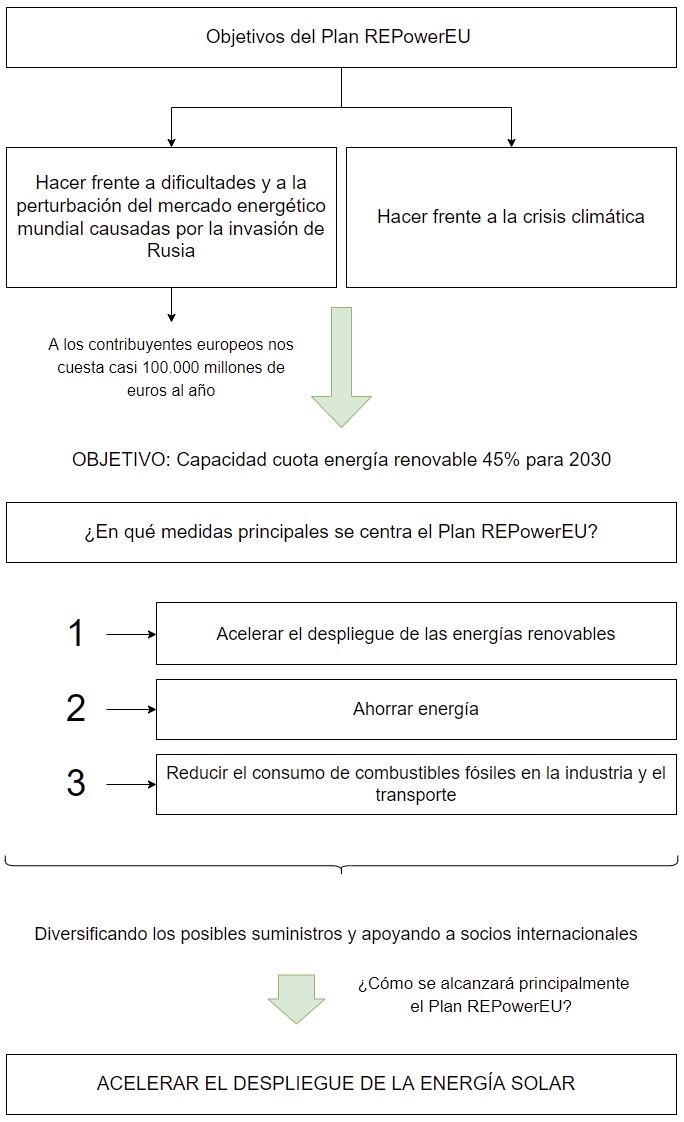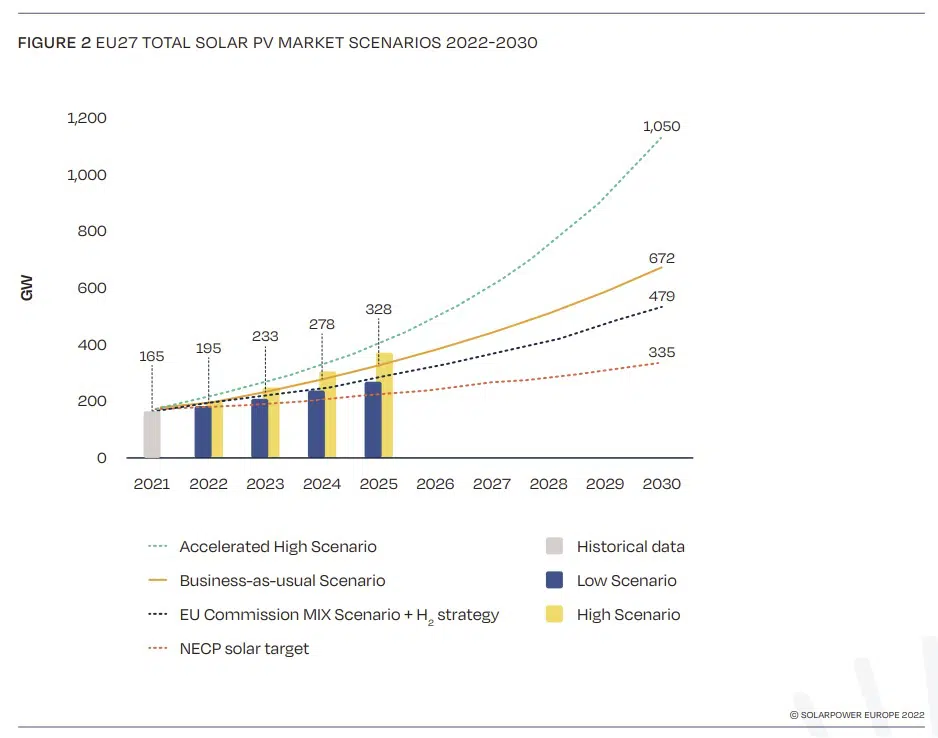Europe encourages solar panels everywhere parts
The European Commission has presented the energy project most ambitious renewable energy in the EU, is called the Plan REPowerEU. A new route that reaffirms the need imperative of a radical energy change in the territory European.
The EU proposes to increase the headline target for 2030 of renewable energies from 40% to 45% in the framework from the Fit for 55 package. Noting that the sector of solar energy will be the «punta de landa» increasing almost the double the specified plans for 2025 crazy!
To understand the importance that the field of photovoltaic, we leave the following scheme:

According to Europe… «the infinite energy of the sun will help to reduce our dependence on fossil fuels in all sectors of our economy»
Content menu:
- What are the main objectives of the Plan REPowerEU?

- 1.- Accelerate the deployment of renewable energies
- 2.- Energy saving
- 3.- Reduce the consumption of fossil fuels in transport and industry
- What will happen to the photovoltaic sector?
- Is the objective of the solar sector viable?
What are the main objectives of the Plan? REPowerEU?
The massive and rapid deployment of renewable energy is the core of the REPowerEU plan. The EU initiative to end dependence on Russian fossil fuels and to combat climate change.
1.- Accelerate the deployment of energies renewables
- A specific solar strategy to double the photovoltaic solar capacity by 2025 and install 600 GW for 2030.
- A solar roof initiative with an obligation progressive law to install solar panels on new public and commercial buildings and in new buildings residential.
- Doubling the rate of implementation of heat pumps and measures to integrate geothermal energy and solar thermal in heating systems.
- Speed up permitting for large projects renewable energies, and a specific modification of the Directive on renewable energies to recognize them as public interest. Member States should establish specific areas for renewable energies, with processes shorter and simplified authorization periods in areas with fewer environmental risks.
- Set a target of 10 million tons of national production of renewable hydrogen and 10 million tons of imports by 2030, in order to replace natural gas, coal and oil in industries and transport sectors difficult to decarbonise.
- An action plan for the field of biomethane, tools and financial incentives to increase the production up to 35,000 million cubic meters by 2030, including through the Common Agricultural Policy.
2.- Energy saving
- Promote long-term energy efficiency measures term, including increasing from 9% to 13% of target binding energy efficiency under the package European legislation Fit for 55.
- Carry out specific communication campaigns aimed at homes to save energy and industry. The EU has published a recent guidance document on saving energy where the EU states can support each other.
- Through fiscal measures to encourage energy savings, such as reducing the types of VAT on heating systems, the insulation of buildings and household appliances or products with high energy efficiency.
- The Commission also establishes protection measures contingency in case of serious interruption of the supply, and will publish guidance on the prioritization criteria, as well as a coordinated plan of reduction in demand in the EU.
3.- Reduce fuel consumption fossils in transport and industry
- The EU will implement different systems administrative costs to support the adoption of hydrogen industry by industry and funding specific to REPowerEU.
- A package of measures for greening will be presented of the transport of goods.
- Proposes to create a solar industry alliance European Union and large-scale competition associations to create stronger and more stable bonds.
- Work will be intensified on the supply of critical raw materials and prepare a proposal legislative.
- A possible legislative initiative to increase the proportion of zero emission vehicles in the parks public and corporate automobile from a certain size.
Although the new strategy involves all sectors supported by renewable energy. The solar sector, will be the great beneficiary of this new future energetic.
What will happen to the sector photovoltaic?
Solar energy has a number of advantages especially suitable for facing energy challenges current: can be deployed quickly, costs they have gone down radically, the installation is easy, the people recognizes the solar sector, and, above all, in Europe there is sun.
THE REPowerEU Plan aims to put online more than 320 GW of photovoltaic solar energy by 2025 (more than double that of in 2020) and almost 600 GW by 2030.
In order to reach this ambitious objective, the European Solar Rooftops Initiative of Solar Covers – Consult documents from HERE) and others elements of "less depth"...

The EU plans to impose:
- Limit the duration of permissions for rooftop solar installations, including large ones, at a maximum of 3 months.
- Make provisions to ensure that all new buildings are "energy ready" solar».
- Make the installation of solar energy mandatory on rooftops for:
- All new public and commercial buildings with a useful area of more than 250 m2 by 2026.
- All existing public and commercial buildings with a usable area of more than 250 m2 before 2027.
- All new residential buildings for 2029.
- Ensure that their legislation is fully implemented in all Member States, allowing consumers of multi-story buildings can effectively exercise their right to collective self-consumption, without undue costs.
Remember our interesting article on the guarantees of solar panels will help you make better choices!
The EU and Member States will work together for:
- Remove administrative obstacles to cost-effective facility expansions already existing.
- Establish at least one energy community based on renewable energies in each municipality of more than 10,000 inhabitants by 2025.
- Ensuring that poor and vulnerable consumers have access to solar energy,
For example, through social housing facilities, energy communities or aid to finance individual installations. - Support photovoltaic installations integrated into the buildings, both new and renovated.
- Ensure full implementation of the provisions of the Energy Efficiency Directive of the Buildings (EPBD) in relation to the building standard of almost zero energy consumption for new buildings, even through specific orientations.
Member States should:
- Establish strong support frameworks for systems of roof, even in combination with the storage of energy and heat pumps, based on times of predictable amortization of less than 10 years.
- As part of that framework and where necessary to unlock investments, establish a national program of support to guarantee from next year:
- Mass deployment of solar energy on rooftops, prioritizing the most suitable buildings for rapid interventions (certificate classes of energy performance A, B, C or D),
- Combine solar deployment with renovation of rooftops and energy storage; this should be carried out through a single window that integrate all aspects.
Is the objective of the sector viable? solar?
The easy answer would be to say no. If there is desire and intention it will be possible! And to prove it, we have the recent Solar Power Europe report.

The above paper highlights eight actions that would help Europe accelerate solar deployment for reach a total capacity of 1 TW by 2030.
Overall, to comply with this new framework of the REPowerEU, the EU will additionally invest 210,000 million euros by 2027. Given that 225,000 million euros in loans are already available within the framework of the RRF (Recovery and Resilience Facility – Recovery and Resilience Mechanism).



